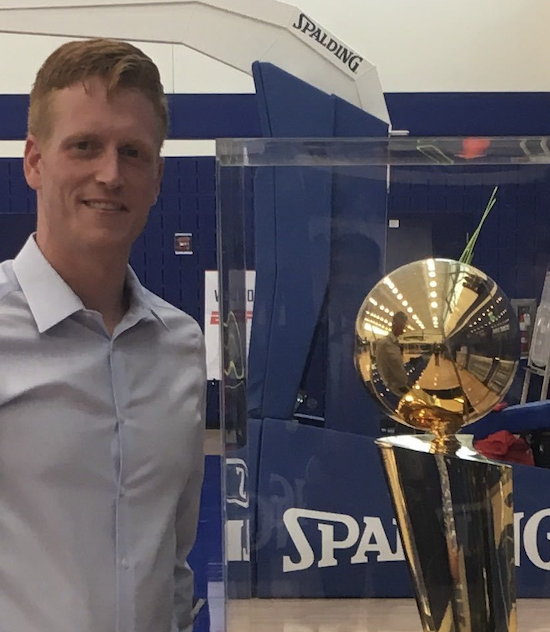Business
What Are the Odds? A computational neuroscientist and Kogod adjunct scores a career as a data scientist with the NBA.

So much of our everyday life involves making predictions—from picking the best route for our morning commute to bringing an umbrella to choosing a partner. “We predict all the time, so the process is natural,” says Grant Fiddyment, adjunct professor of predictive analytics at Kogod and data scientist for the NBA’s Philadelphia 76ers. “In a lot of ways, it’s the same way we interact with technology and the world. For instance, how can I phrase my web search so that the site will match what I’m looking for? How can I pronounce a word so that a virtual assistant will understand what I’m saying? Without knowing the technical details, we implicitly learn how these technologies work.”
What is predictive analytics, and how does it offer us a glimpse into the future?
At its most fundamental level, the discipline calculates the likelihood of future events by simply (although many would cry foul at this characterization) counting the possible outcomes. Its foundations were laid in a 1654 letter exchange between French mathematicians Pierre de Fermat and Blaise Pascal discussing how the winnings of a coin-flipping gambling game should be split. And while we all know that the house always wins in Vegas, few would know to credit Jacob Bernoulli’s Law of Large Numbers from 1713 as the reason why.
Despite predictive analytics’ old roots, it is responsible for many facets of modern-day life we give little thought to—things like credit card fraud detection, virtual chess partners, and, of most interest to Fiddyment, creating professional sports super teams.

As a data scientist on the research and development team for the 76ers, Fiddyment helps frame and analyze the predictive questions that arise in sports—for example, how will signing a new player impact a team’s title odds, or how well will a tall lineup play against a smaller, quicker one?
Predictive analytics has long been used in sports, going back to the analog days of yore. Baseball has historically led the movement. One of the most famous success stories is told in the movie Moneyball, which follows 2002 Oakland Athletics general manager Billy Beane as he uses predictive analytics to hire under-valued players and send his team on a crowd-wowing 20-game winning streak. But the methods developed in Oakland have application across all sports.
“Most teams were asking, ‘How often does a batter get a hit when they go to bat?’ Instead, the A’s asked, ‘How many bases does a player get when they go to bat?’ Looking at total bases turns out to be more predictive of how many runs a team will score,” explains Fiddyment. “Similarly, in the NBA, teams used to ask how often a player will make a shot. But this overlooks the fact that all shots are not equal. So now teams are asking, ‘How many points will a player get when they take a shot?’”
In the past decade the number of three-point shots in the NBA has increased. Is the rise just due to random luck or is it part of a well-crafted strategy? Fiddyment and other fellow data scientists employed full-time by sports teams work to answer new questions like these. He credits the invention of video tracking as the proverbial game changer. “Chip or camera-based systems will follow players as they actively play a sport, and the data we get is much more nuanced than a single-number summary,” says Fiddyment. “For example, we can answer how many pick-and-rolls the team ran last game or how open were the shots they generated. We can analyze the individual and team as a whole.”
At the moment, this kind of data collection is limited to professional teams, making it difficult to spot up-and-coming superstars. “College and international teams typically don’t have the same camera systems, so projecting which players will become successful remains a very challenging problem,” Fiddyment says.
Despite rapid advancements in technology, however, not all data is created equal—or, perhaps, equally useful. The limitations of data translate to limitations in predictive accuracy (as meteorologists can confirm). “We need to be aware of computers’ strengths and weaknesses,” Fiddyment advises. “Computers can process vast amounts of data much more quickly than humans ever could. But they are restricted to the data they have and operate very literally, so we should never expect them to behave exactly like a human, even if they can match our performance at a given task.”
From the glitz of Vegas to the life-saving powers of storm forecasts to the way opinion polls affect voters, predictive analytics is ever-present in our lives. Advances in machine learning and big data models are improving our ability to look into the future, but they are also raising some thorny issues, one of the most notable being the boundaries of data privacy. For now, however, Fiddyment has scored a slam dunk for the NBA.